Reposted from Polar Bear Science
Posted on November 11, 2019 |
This is the third year in a row that freeze-up of Western Hudson Bay (WH) ice has come earlier than the average of 16 November documented in the 1980s. Reports by folks on the ground near Churchill confirm polar bears are starting to move onto the sea ice that’s developing along the shore after almost 5 months on land. After five good sea ice seasons in a row for WH polar bears, this repeat of an early freeze-up means a sixth good ice season is now possible for 2019-2020.
Sadly for the tourists, however, it means the polar bear viewing season in Churchill will be ending early this year, just like it did last year and the year before.
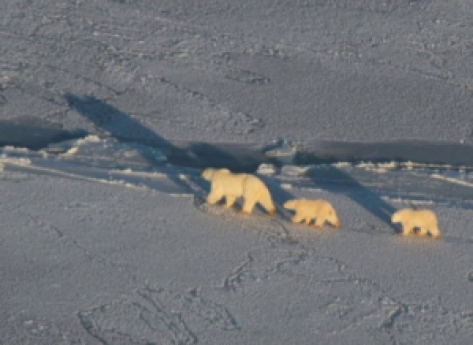
Polar bear family on the ice off Churchill Manitoba (taken from a helicopter), courtesy Explore.org
When mothers with cubs are out on the ice (see photo above), it’s pretty certain the mass movement from land to sea ice is well underway because these family units are usually the last to leave.
Current ice conditions
Weather in Churchill was very cold today, -36C with the wind chill. The slight moderation in temperature in the forecast for the rest of this week is still very conducive to ice formation:
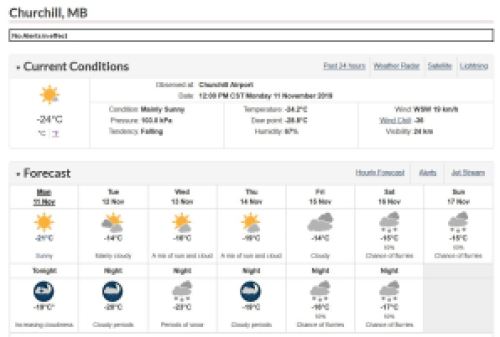
The Canadian Ice Service charts for 10 November 2018 below (the overall picture and the details for ice development in northern Hudson Bay) show the ice conditions last year at the time that bears left for the ice:
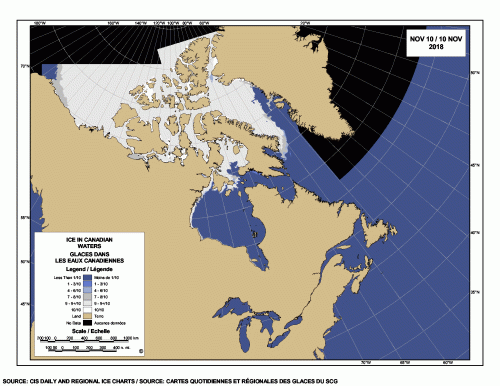
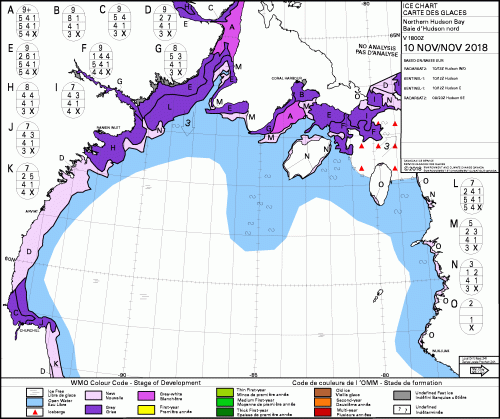
Below is what the ice looks like this year (11 November 2019): while the band of ice is not quite as thick as last year at this time, recent cold weather has led to solid ice formation along the west coast of Hudson Bay and into James Bay (home to Southern Hudson Bay bears). This ice is guaranteed to widen and thicken over the next few days, putting this year only a day or two behind last year and 2017.
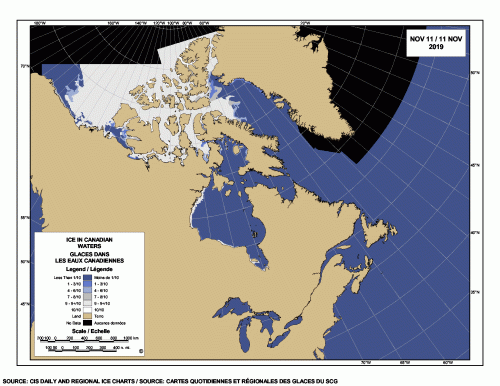
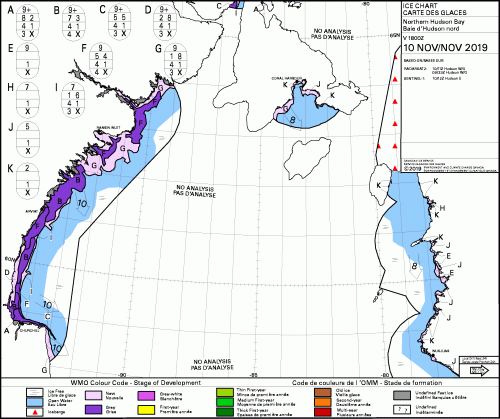
Just to round out the comparison, below is the detailed ice development chart for 11 November 2017:
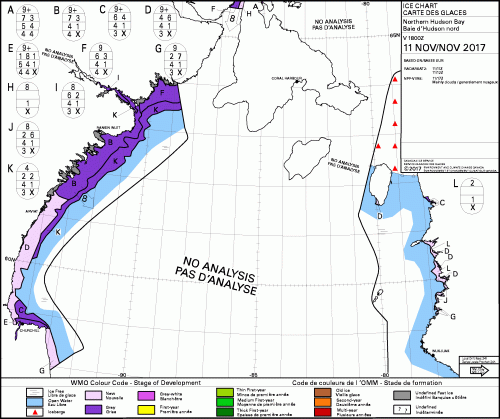
Freeze-up dates since 1979
Like Andrew Derocher’s student Laura Castro de la Guardia, I am using a definition of “freeze-up” that describes the behaviour of polar bears to newly formed ice, not the date when fall ice coverage on the bay reaches 50% (e.g. Lunn et al. 2016).
According to a recalculation of WH data that goes up to 2015 and back to 1979 (Castro de la Guardia 2017, see graph below), in the 1980s bears left for the ice at freeze-up (10% sea ice coverage) about 16 November ± 5 days while in recent years (2004-2008) they left about 24 November ± 8 days, a difference of 8 days. In other words, the relative change in the dates that WH bears left the shore between the 1980s and recent years is only about 1 week (with lots of variation).

Figure 3 from Castro de la Guardia (2017) showing freeze-up and breakup dates and ice-free days 1979-2015 for Western Hudson Bay, showing that the earliest freeze-up dates since 1979 (top panel) came on 6 November, Day 310 (in 1991 and 1993).
Therefore, freeze-up dates of 10-12 November or so (Day 314-316) for 2017, 2018, and 2019 are some of the earliest freeze-up dates recorded since 1979 (the earliest being 6 November, Day 310, in 1991 and 1993), even earlier than the average for the 1980s.
Virtually all Western Hudson Bay bears leave the shore within about 2 days of sea ice concentration reaching 10% (Castro de la Guardia 2017; Cherry et al. 2013), although Southern Hudson Bay bears leave when it reaches about 5%: in other words, the bears go as soon as they possibly can.
As I discussed in 2016 regarding newly-published studies (Obbard et al. 2015, 2016) on the status of Southern Hudson Bay (SH) bears:
“…SH polar bears left the ice (or returned to it) when the average ice cover near the coast was about 5%. This finding is yet more evidence that the meteorological definition of “breakup” (date of 50% ice cover) used by many researchers (see discussion here) is not appropriate for describing the seasonal movements of polar bears on and off shore.”
Here is the week 19 report from the 2018 Churchill Polar Bear Alert Program (November 4-11 — almost 5 months ashore), confirming that bears were moving onto the rapidly forming ice by the first week of November last year:
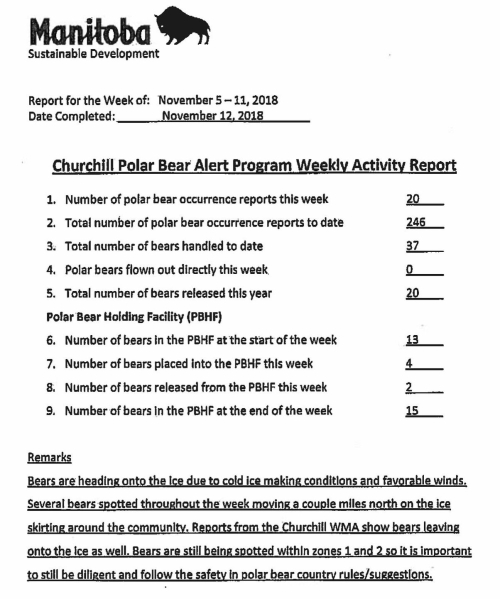
For 2019, the town of Churchill is behind in their posting of problem bear reports (the last one listed is 28 October) but I’ll insert the relevant status sheets for the season’s end here as soon as they are available.
My 2017 Southern Hudson Bay post (with its list of references) is worth another look for its discussion of the following points: the definition of freeze-up; the relationship of official freeze-up and breakup dates to the dates that bears depart; the overall health and survival of Western and Southern Hudson Bay polar bears.
A final note: if PBI spokesperson Amstrup had been right about his predictions of Arctic sea ice and polar bear survival back in 2007 when he was the head of the US Geological Survey’s polar bear research team, there would be no polar bears at all in Hudson Bay right now (Crockford 2017, 2019), not a thriving population of fat, healthy bears moving offshore as early as bears did in the 1980s.
References
Castro de la Guardia, L., Myers, P.G., Derocher, A.E., Lunn, N.J., Terwisscha van Scheltinga, A.D. 2017. Sea ice cycle in western Hudson Bay, Canada, from a polar bear perspective. Marine Ecology Progress Series 564: 225–233. http://www.int-res.com/abstracts/meps/v564/p225-233/
Cherry, S.G., Derocher, A.E., Thiemann, G.W., Lunn, N.J. 2013. Migration phenology and seasonal fidelity of an Arctic marine predator in relation to sea ice dynamics. Journal of Animal Ecology 82: 912-921. http://onlinelibrary.wiley.com/doi/10.1111/1365-2656.12050/abstract
Crockford, S.J. 2017. Testing the hypothesis that routine sea ice coverage of 3-5 mkm2 results in a greater than 30% decline in population size of polar bears (Ursus maritimus). PeerJ Preprints 2 March 2017. Doi: 10.7287/peerj.preprints.2737v3 Open access. https://peerj.com/preprints/2737/
Crockford, S.J. 2019. The Polar Bear Catastrophe That Never Happened. Global Warming Policy Foundation, London. Available from Amazon in paperback and ebook formats.
Lunn, N.J., Servanty, S., Regehr, E.V., Converse, S.J., Richardson, E. and Stirling, I. 2016. Demography of an apex predator at the edge of its range – impacts of changing sea ice on polar bears in Hudson Bay. Ecological Applications 26(5): 1302-1320. DOI: 10.1890/15-1256
Obbard, M.E., Stapleton, S., Middel, K.R., Thibault, I., Brodeur, V. and Jutras, C. 2015. Estimating the abundance of the Southern Hudson Bay polar bear subpopulation with aerial surveys. Polar Biology 38:1713-1725.
Obbard, M.E., Cattet, M.R.I., Howe, E.J., Middel, K.R., Newton, E.J., Kolenosky, G.B., Abraham, K.F. and Greenwood, C.J. 2016. Trends in body condition in polar bears (Ursus maritimus) from the Southern Hudson Bay subpopulation in relation to changes in sea ice. Arctic Science 2: 15-32. DOI: 10.1139/AS-2015-0027
It’s difficult to see how this story can be twisted into some “climate emergency” news, but I’ll give it a try:
“As a result of unstable Arctic Air pushing southward from the Pole, which is a direct consequence of Global Warming, Polar Bears are being given a false sense of security and venturing into territory that will leave them stranded to perish en masse, when the ice surrounding them melts quickly, and leaving them no avenue to return to any land. The World can witness this Mass Murder and ponder their inability to address a Crisis brought to their attention decades ago.”
(Copy written and may not be reproduced without permission)
A short version:
Number of white bears seen near Churchill decreasing rapidly !! –> Climate change.
Polar bears driven offshore by walruses driven mad by climate change. Greta says, “How bear you”!
Thump!
Thump!
Thumps!
Ah, the sounds of polar bear alarmists in Manitoba punching their walls or hitting the walls with their sodden heads in frustration.
The cycle is turning colder and they failed to prove their alleged science.
Inclement weather.
That pretty much shuts down the Northwest Passage for this year.
so any minute now some idiot in a kayak will post about their trip??
“very cold today, -36C with the wind chill” – What’s that as a real temperature without exaggeration?
If you read the data chart given you’ll see that it was -24ºC but will have ‘warmed up’ to the -teens by now.
I agree with Roger, using the wind chill is not a very good way to describe temperature of the air. We all know it is only a comparative of how the real temperature affects exposed human skin.
But wind will also increase the rate of heat loss from exposed water too. The question is whether the surface turbulence will draw up warmer water and slow the ice formation, but I think there is no doubt that more heat energy is being removed per unit of area when it is windy. I live on a northern lake and have seen two slightly different phenomena when a cold north wind blows as winter begins. One is when the wind blows persistently and forms ice on the lee shore, spreading gradually windward. The other is when the wind abruptly stops and one gets an instant freezing of supercooled water, creating 3 inches or so of flat transparent ice. The former phenomenon produces rough (not good for skating) ice as platey bits freeze at all orientations in the growing mass. The latter produces exquisite ice so clear that one is nervous about walking on it, viewing all of the vegetation in the shallows.
The line in question was:
“Weather in Churchill was very cold today, -36C with the wind chill.”
It would have been better to say “the temperature was -24C with a windchill of -36C.”
That way no one can accuse the writer of trying to over hype.
But either way it was freakin’ cold.
Dunno as it’s definitely not my field so handball that one to the climastrologists to address that question to the polar bears at the scene. Headed for 39C down here on Wednesday so I’ll mull it over then if it’s windy.
But you can be sure that this November will be the warmest evah!
You might be talking about Alaska. Chukchi refreeze a MONTH behind.
https://twitter.com/AlaskaWx
It would be nice if sometimes you took the time to say something useful or interesting, instead of these drive-by one-liners. Yes Chukchi Sea is warmer and ice free right now, but everyone could see it coming for the last 6 months. Lots of warm water has made its way to the North Pacific. The bearing is shallow and the Chukchi Sea is on the other side of very narrow passage. That makes the area actually an excellent place for ocean heat to be dissipated in the polar night. Once all the warmth from this surface water is vented to space, temps will plummet. Meanwhile the warm water is shunting cold air to the east, leading to colder weather in eastern canada.
Dr Crockford’s meticulously scientific take-down of alarmist wishful nonsense concerning polar bears and the Arctic, is all the more forceful and poignant due to her political sacking for speaking the truth. I’m very impressed that Dr Crockford always communicated without without rancour and in a calm measured way, precisely, scientifically and informatively. In spite of the bad stuff constantly directed towards her from the lazy alarmists.
Maybe in future a film will be made of her heroic stand for the truth in the face of such powerfully entrenched and viscious opposition.
Phil,
“Maybe in future a film will be made of her heroic stand for the truth in the face of such powerfully entrenched and vicious opposition.”
Maybe. Don’t hold your breath.
Can you see any of the entitled luvvies in Hollywood outing themselves as realists?
That’s what making a film like that would involve.
They are – almost to a person – ‘woke’, and desperate to be popular.
Just watch any of their ‘awards’ ceremonies.
Auto
😞 I thought it was going to get warmer, Al bore and vile saint greta lied… The bbc, the guardian, cnn, fox, ipcc, u.n. (Add every other news media) XR They have all lied, yet the greens still say that the polar bears are almost all gone..
For 2019, the town of Churchill is behind in their posting of problem bear reports (the last one listed is 28 October) but I’ll insert the relevant status sheets for the season’s end here as soon as they are available.
This happens a lot. When climate data go against the warming story, whether it’s Arctic ice or ocean temperatures or any other, then the data starts drying up. Updates slow down or stop if they the data are straying from the party line.
Like no major stories on the Northwest Passage this year. Wonder why, sarc.
This article really is extremely stupid.
Find one tiny area where sea ice develops earlier than average, when vast tracts are later than average. Then cry shrilly that this means Arctic Ice is normal….
Chukchi sea? Along the Eastern seaboard of Greenland? SW of Baffin Island?
I am as skeptical as the next man, but you do not emulate a syphilitic man by contracting gonhorrhea…leave the fact-free drivel and misdirection to the ER bedwetters….
Just like screaming ‘Ice Age, ice age!’ when US midwest has a cold snap is silly when Western Russia and Ukraine are 10C warmer than average at the same time.
There is a systemic failure in all media when the only core messages are two equally crazed ones far from the reality in the middle…
You’re right, Rhys, all of this stuff is diverting from the fact that those poley bears are really cute, in fact, I think you should go and pet one (let us know how it turns out).
lts funny that you talk about the warming in western Russia, yet fail to mention the well below average temps hitting northern and central Russia. As the jet stream from the Arctic drives cold air down across these areas.
Yeah, he failed to mention how anomalously warm the Arctic is at the moment too ….
American friend in UFA is pretty browned off
bugger all summer sun or warmth at all,
and theyve now had days of ZERO C still, icy ,nasty cold.
This article really is extremely stupid.
You are reading into it what is not there.
Dr Crockford is not commenting on Canada-wide climate trends. The focus is the polar bear community in Hudson Bay. And it is the sinecured activists, not Dr Crockford, who have been tracking the date of polar bear migration to sea ice and using it to claim a warming trend. The author here is simply saying that, for the polar bears of Hudson Bay, that trend of later fall migration to sea ice has stopped.
Much of Canada has had a really bad harvest due to cold and shortened growing season:
https://www.iceagenow.info/millions-of-acres-of-canadian-canola-freeze/
But hey – somewhere in Asia is hot so none of this matters I guess.
Phil Salmon
“Much of Canada has had a really bad harvest due to cold and shortened growing season…”
And… what did the farmers in the Canadian Prairies do in the past? Here is a sort of the averaged October anomalies wrt the mean of 1981-2010 for Alberta + Saskatchewan + Manitoba:
1919 10 -6.55
1925 10 -5.07
2002 10 -3.83
1991 10 -3.25
1905 10 -3.03
1932 10 -2.96
1951 10 -2.85
1913 10 -2.83
1930 10 -2.78
1939 10 -2.61
1969 10 -2.59
1959 10 -2.52
1933 10 -2.51
1917 10 -2.42
1972 10 -2.39
2012 10 -1.83
2009 10 -1.79
1946 10 -1.67
1928 10 -1.63
2019 10 -1.54
Any idea? Btw, September was on average, as opposed to 2018 🙂
Some Coolistas are really as pathetic as are Warmistas.
ok so colds not unusual
but is it being SNOWED under and unharvestable also what happened in those prior listed cold years?
serious ask , do you have that data at all?
Looks like GISS adjusted data, where historic data is adjusted down and more recent years adjusted up.
The US cold snap was record setting, and the reason for above average temps in the Ukraine and west Russia is obvious, a warm wind moving water vapor off of the Black and Caspian Seas on a northward trajectory. … https://earth.nullschool.net/#current/wind/surface/level/overlay=temp/orthographic=-325.72,51.36,1823/loc=27.742,49.221
I think about three years ago the Delicious Kate Humble in her anorak with fetching fur (?real) framing her beautiful face had a BBC TV spot saying that polar bears were leaving Churchill because of lack of ice due to Global Warming. She also had a go at the Yellowstone National Park which nearly convinced me that we are all doomed, ho ho.
Water on the mill. It’s getting colder, much colder and in just a few years we will wonder how there was ever any talk of global warming. Wanna be crazy? Mark my words – in some years time we will think about ways to get more CO2 into the atmosphere as not only will the CO2 driven global warming theory be dead but the colder weather will require higher CO2 concentrations to make plants grow. Time is running against the Alarmists and they know it. That’s why they are so restless and radical now. They still need to make their money as their scam will fall apart soon.
I predict a news blackout at Climate Pravda.
The Canadian Ice Service is showing that the ice in this area is behind the average.
https://ice-glaces.ec.gc.ca/prods/WIS54DPTCT/20191111180000_WIS54DPTCT_0010848823.pdf
Hmm – who to believe about Hudson ice?
Polar bears who live on it?
Or a warm office full of sinecured climate activists?
So perhaps we should wait for the data on the bears rather than making assumptions?
As of the most recent data the bears were behind 2018.
‘Average’ is a nearly irrelevant term when there is such a wide range of normal.
Look at the polar vortex in the lower startosphere. The coldest wind from Siberia flows over Hudson Bay.
https://earth.nullschool.net/#current/wind/isobaric/70hPa/orthographic=-101.91,93.09,515
http://masie_web.apps.nsidc.org/pub/DATASETS/NOAA/G02186/latest/4km/masie_all_r10_4km.png
There is more to knowing where the climate is going than “it’s cold here but it’s warm there”. The locations matter.
The major glaciation of the last glacial maximum was nucleated and spread out from two locations – Canada, and the Fennoscandian mountains in Scandinavia. Therefore deepening cold in these two regions has a different significance than the patchwork of warming and cooling elsewhere.
Climate trends are likely linked to specific geographic patterns, and are not about statistical average temperatures.
https://www.iceagenow.info/typical-january-weather-in-sweden-except-it-is-november/
https://www.iceagenow.info/huge-amounts-of-snow-in-tromso-most-in-almost-a-hundred-years/
https://www.iceagenow.info/record-cold-across-ontario/
https://www.iceagenow.info/millions-of-acres-of-canadian-canola-freeze/
PBI through its compliant press agents is pushing this as disastrous warming:
https://www.mirror.co.uk/news/world-news/exhausted-polar-bears-cling-life-20875630
And still pushing the extinction canard!
Churchill Temperature

High & Low Weather Summary for the Past Weeks
https://youtu.be/2flZ5UfgzC8
This chilling video taken by the Russian military – no doubt in protective suits – shows graphically the environmental destruction in the Arctic caused by climate. The music evokes the sad dreary miazma of ecosystem collapse.
Birds cling to a last holdout on precarious cliffs – never before have they been forced to nest their young precariously on vertical cliff edges – each one that falls to their death adds to a mountain of human guilt for such a tragedy. A polar bear lies dying by a poisoned creek – howling mournfully.
Alas the blighted seals have developed grotesquely overgrown front teeth – a quick fact-check from David Attenborough confirms this horrible mutation is quite new and without doubt caused by chemical contamination. Icebergs melt under a relentless sun into hideous shapes before disappearing forever. Has even time itself gone haywire? Another polar bear struggles in vain for life. Pure instinct refuses to surrender to merciless climate.
Adding insult to injury, human vandals damage centuries-old ice with an axe – have you no shame? Mutated seals languish in fetid stagnant pools. International tourists look on from a pleasure-boat. In panic a polar bear flees the stench from the polluted waterline and despairingly climbs a mountain face. Party-goers ignore the devastation and wave banalely at a camera. How dare you?! Where is Greta Thunberg when we need her?!
/sarc
in case you hadn’t noticed 🙂
What follows is no /sarc 🙂
I have sometimes the impression that ‘Phil Salmon’ is kinda pseudonym for Robert W. Felix:
https://rationalwiki.org/wiki/Robert_W._Felix
because not one person posting here presents so often so many links to one of the the dumbest, scariest pseudoclimate web sites we could imagine, namely ‘iceage.info’.
Let us look at one of Mr Salmon’s newest inventions:
The major glaciation of the last glacial maximum was nucleated and spread out from two locations – Canada, and the Fennoscandian mountains in Scandinavia. Therefore deepening cold in these two regions has a different significance than the patchwork of warming and cooling elsewhere.
What deepening cold ???
OK: when we look at Copernicus for October 2019, we see:
Indeed, it doesn’t look so terribly warm in Northern Europe in the chart above for that month, this poor UK included.
But…
1. When building the ascending sort of all GHCN daily TMIN temperatures measured in Norway, Sweden and Finland (Denmark you can forget here), you see that the top 100 of the list contains 49 days of 1999, and 27 of 1966. The rest is a mix of years between 1914 and 1987.
2. While the average temperature for the top 100 is -48 °C, that for the coldest days in 2018 and 2019 is -38 °C.
We are far far away from any ‘deepening cold’ in Scandinavia and Finland.
We are indeed in some deepening cold within Northern CONUS since a few years.
A look at a stat I made for the winter months in 12 states of Northern CONUS from 1900 till now, convinces us that something bad happens:
https://drive.google.com/file/d/1RL6dA_EtMkZPcMHk-fIwdTgt33JKZPip/view
But that is no reason to invent scary material about global cooling.
Btw, we experience in Northern Germany for the third year in sequence a wonderful, mild weather. Weiter so!
*
As I said so often: Warmistas are no good people, but Coolistas are even worse.
The cold regions of Siberian are ahead of schedule this year. Note the winds moving to the west out of frozen Siberia, and into Eastern Europe. Looks to me like that cold front is going to march westward, … https://earth.nullschool.net/#current/wind/surface/level/overlay=temp/orthographic=-323.66,52.66,1107/loc=43.833,53.437
Bindidon
The fact that you actually believe the politicised climate fiction emanating from the expensive agencies like NASA staffed by sinecured activists, is funny yet sad. Every month is now the warmest ever despite shortened growing season and poor harvests in North America and multiple cold and snow records. It’s just too easy to fiddle the baselines out of public view, isn’t it? Eternal warming of the spotless mind. PAGES are doing a heroic job of editing the past also – destroying palaeoclimatology and flattening the Holocene.
Warming is always where there are no people, oddly. Mid oceans, poles, Siberia. Yeah right.
Robert Felix might have eccentric ideas about climate and magnetism, but his site reports weather / climate realities that the climate establishment consumes taxpayers money trying to hide.
Omission: impossible
https://drive.google.com/file/d/1PDTztJSK_yODrLaAwNyzuDkyE67Q40gY/view
illustrates the current difference between CONUS and Northern Europe (Denmark, Norway, Sweden and Finland).